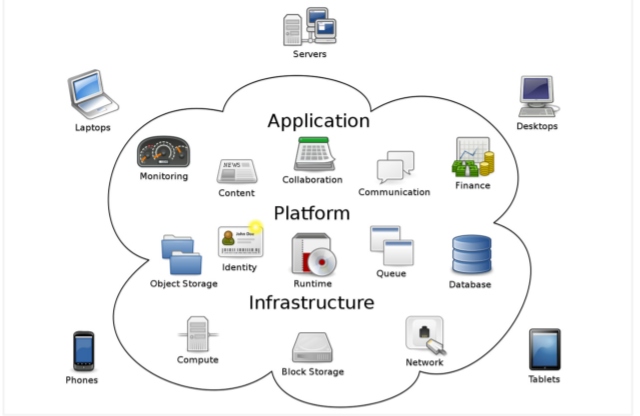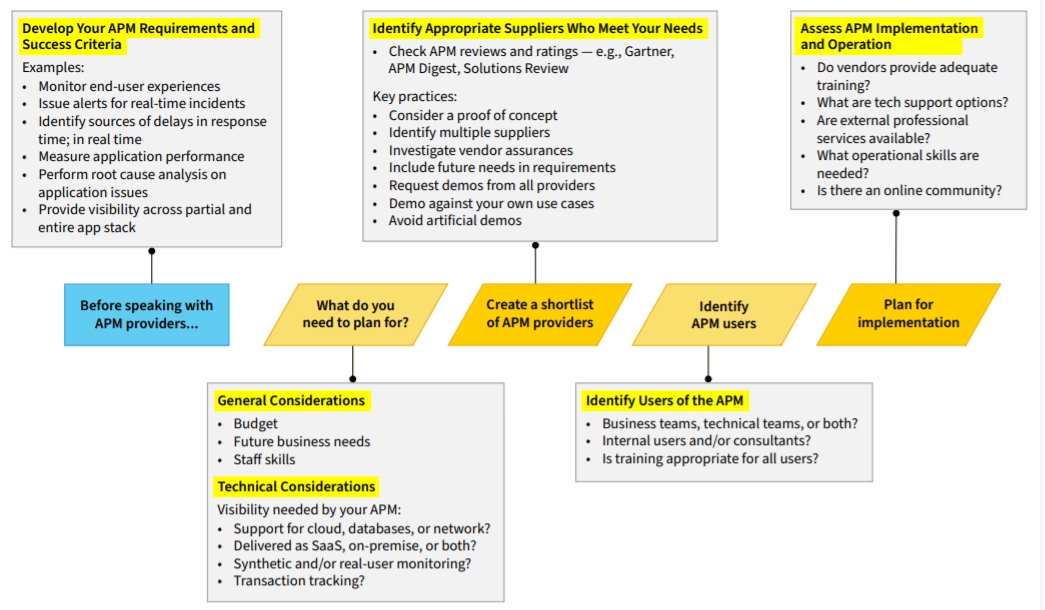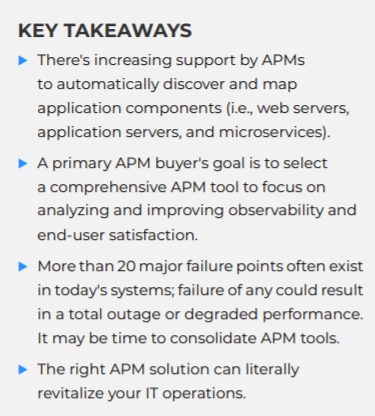Developing Your Criteria for Choosing APM Tool Providers
APM tools allow you to monitor and manage the performance and uptime of your applications. Learn helpful criteria for choosing an APM tool provider here.
Join the DZone community and get the full member experience.
Join For FreeThis is an article from DZone's 2021 Application Performance Management Trend Report.
For more:
Read the Report
Selecting an application performance management (APM) solution can be a big undertaking as many factors must be considered. Each available tool delivers different feature sets; some tools only provide a view into particular layers of your stack but not complete visibility.
Further, several tool options are designed to run only on specific operating environments. Careful consideration of each APM solution is essential to ensure that it meets budgetary requirements and specifications. A primary goal is to discover comprehensive toolsets that focus on analyzing and improving the performance of end-user experiences.
APM tools allow you to monitor and manage the performance and uptime of your applications. For example, an APM tool can enable IT teams to monitor applications' speeds and response times to maintain SLAs (service-level agreements). If applications are below a specific threshold, the team can be alerted immediately, and the issue can be diagnosed to avoid bottlenecks or delays.
![Key Takeaways]() Before Choosing a Vendor, Identify Your APM Needs
Before Choosing a Vendor, Identify Your APM Needs
Consider the system diagram for a web application shown in the image below. In this configuration, there are nearly twenty IT components that are potential points of failure. Errors in any sub-systems could result in a complete outage or degraded performance of the application.
A frequent challenge is to procure a new or different APM solution and decide which best suits your environmental requirements. The solution that is easy to deploy and maintain while delivering on your requirements is the one you should seek.

Begin by Clearly Defining Your Requirements
Reasons your organization needs to upgrade its approach to application performance management may seem simple. However, the current technologies and tools it relies on are inadequate. The reasons they are lacking are complex but exploring them will help you define the requirements for the new APM solution you'll choose. The chart below should help you get started with establishing your APM needs before reaching out to providers.
Conduct research, evaluate the sample criteria presented here, and add your own where needed. Carry out a rigorous proof of concept (POC) with the vendor's assistance and work with at least two or more vendors before deciding on a solution.
Tips to Help You Select an APM Solution
Each computing environment is composed of multiple platforms, operating systems, applications, and networks. It is important to list, review, and compare various APM tools to ensure that the one (or several) you choose meets your organization's requirements, budget, and staffing. Modern APM core functions include:
- Ability to integrate with other automation and service management tools
- Advanced alerting and reporting
- Features for error detection (e.g., root cause, multidimensional, stack trace for debugging)
- Analytics for business KPI and user paths (e.g., login to logout)
- Monitoring across application environments (e.g., mobile to mainframe)
- Automatic discovery and mapping of applications and their infrastructure components
- Integration with APM data from third-party sources
- Identifying problems and analyzing root causes
- Observability of applications' HTTP transactional performance
- Support for APM integrations and plug-ins
- Support for programming languages and frameworks (e.g., Python, Node.js, AngularJS, Java, Ruby)
Principal APM users include:
- Application owners and business users
- DevOps, ITOps, DataOps, and CloudOps teams
- Digital experience monitoring (DEM) and end users
- Site reliability engineers (SREs)
The APM requirements and selection process should quickly reveal features deemed essential for your organization. Users may access your apps from anywhere in the world through different browsers, devices, and connection speeds. Identify an APM tool or platform that provides real-time visibility into your websites, web services, infrastructure, and networks; simultaneously, the tool should include features that complement your monitoring objectives
Research APM Solutions Through Industry Expert Reviews
Descriptions, reviews, and ratings of leading APM features are detailed in "2021 Gartner Magic Quadrant for APM Monitoring," Solutions Review's Application Performance Monitoring Solutions Directory, and the APM Digest website.
Many reputable resources are available to help guide you during the research process before adopting a solution. Look for experts and analysts in the industry who have researched, assessed, and collected reviews of leading providers and specific tools. In particular, groups such as Gartner and Solutions Review have resources dedicated to APM. The table below contains a summary of notable APM capabilities compiled by Solutions Review and offered by one or more of Gartner's top providers described as "Leaders" in the space.
| TRENDING CAPABILITIES OF LEADING APMS IN 2021 | |
|---|---|
| Capability | Description |
| Application analytics | • Allows users to analyze the content of critical processes across application hosts to identify performance bottlenecks • Takes your network's blind spots into account, offering a more authentic user experience |
| Applied intelligence | Allows users to detect, diagnose, and resolve problems before their IT staff or customers notice them, enabling them to identify and explain abnormalities for proactive and quick diagnosis and response |
| Automated anomaly detection | • Uses machine learning to automate anomaly detection and response, finding and fixing issues that affect application performance • Helps customers reduce MTTR with root cause diagnostic capabilities |
| Built-in integrations | Several APM solutions offer built-in (embedded) integrations in various categories, including orchestration, containers, service mesh, public cloud, messaging, DevOps toolchain, Internet of Things (IoT), and databases. |
| Code-level transaction monitoring | • Provides end-to-end observability of code-level transactions that affect the key performance indicators, including conversion and revenue • It helps users clearly understand the effect on business performance |
| Code-level visibility | Code-level visibility inspects methods, classes, and threads for requests |
| End-to-end distributed tracing | • Provides distributed tracing from the front end to the database • Tracks requests from RUM sessions to services, serverless functions, and databases, then connects API and browser test failures to back-end errors |
| Full-stack observability | Allows users to visualize, analyze, and optimize the entire software stack, including distributed services, applications, and serverless functions |
| Hybrid environment management | For businesses migrating to the cloud: • Performs real-time, automated performance insights before, during, and after the cloud transformation process • Delivers a consolidated view of application services and infrastructure |
| Integrated health monitoring | • Offers digital performance monitoring that keeps track of all application tiers, including server hosts and network health • Can collate application performance metrics with server resource metrics to provide an integrated view of network and application health |
| Intelligent observability | • Delivers intelligent observability for applications and networks with contextual information, artificial intelligence, and automation • Helps users understand the full context of observed data from user impact through entity interdependencies |
| Telemetry data platform | • Ingests and stores all of a user's operational data, including logs, in one place with live alerts and custom application support • Features several hundred agents and integrations, including OpenTelemetry |
Develop Checklists and Questions for APM Suppliers
Are you familiar with the features and behavior that your APM solution should offer? Setting business goals and objectives (e.g., increased revenue, reduced risk, and costs) is a critical step in selecting the best APM solution for your business. For application owners who utilize a due diligence list, consider the importance of the following information:
| CATEGORIES OF QUESTIONS AND CONSIDERATIONS FOR PRE-SELECTED APMS | |
|---|---|
| Capability | Assessment Questions and Considerations |
| APM data and reporting | • What is the complete selection of APM charts and graphs available? • What type and how many users will access and use the information — C-suite executives who want simplified visualizations to comprehend the data quickly, or are data experts the primary people on the team who should access and interact with the information outputs? • To process and visualize APM data, how many servers would be needed? • Do I need a supporting APM database on separate devices? • If the APM uses agents to collect data, how many and what kinds of agents are necessary to support my implementation? Is it all going to be on our network or the vendor's network? • Is the APM tool able to extract data from other existing tools and correlate the data? • Do you need to recover the data manually, or can it be sent to your development team's existing alert tools? • Does it include an API that allows other tools to extract data from it? |
| Budget and pricing | As you put your new tools (and new expertise) to use to solve more APM problems, you may be presented with opportunities to innovate with outside-of-the-box thinking. Ask yourself: • How much can you spend? • Does the vendor's pricing scheme work for you? • What is included and what options could be more costly? |
| Complexity | • Can your APM solution manage a few applications or hundreds? • Are all of these applications internal, or are they also in the cloud? • What application models are they adhering to (monolithic, service, and/or microservice)? • In what programming languages are applications written? • What is the status of your infrastructure modernization process? • Do you require SaaS solutions alone, on-site, or both? • What additional hardware, software, and/or applications are required to support the APM? |
| End-user | Some APM tools with digital experience monitoring are explicitly designed for application developers, which can be too restrictive for users not involved in development. |
| KPIs | Does the solution you are considering measure the KPIs you require? For example, is the granular data you need to be provided on areas such as diagnostics at the code level or tracking performance under specific parameters such as user location? |
| Integration | You likely have other tools in your organization to help manage and monitor the IT environment. You will want your new APM tool to slide right onto it without creating yet another place to search for data, so: • Learn about the tools that the APM product you are considering integrates with. • Compare APM tools under consideration with tools you already have or are considering implementing. |
| Scalability | • Should the APM solution only address your application and service management issues now, or should it be able to grow as your operations expand? • Does the APM tool tie you to proprietary hardware and/or software? |
| Support | • What options are available? Are they 24/7? • Does the vendor position itself as a partner or more as a product provider? |
Conclusion
Implementing well-chosen APM solutions can renew your computing operations. The economic value your chosen APM solution will provide is remarkable and easily quantifiable. IT infrastructures have grown so complex that the traditional APM "silo" approach doesn't work anymore. Many organizations have a variety of surveillance products deployed. They can be reduced to one or a few in most cases, thereby lowering costs and increasing value.
If you have not assessed your existing application performance management process and tools recently, start looking right now to avoid pressure later. And if you don't have a current APM solution, it is time to consider setting up a proof-of-concept demo with prospective providers. It will cost nothing up front, and the vendors will be eager to show you how their products can bring value to you and your team.
This is an article from DZone's 2021 Application Performance Management Trend Report.
For more:
Read the Report
Opinions expressed by DZone contributors are their own.

 Before Choosing a Vendor, Identify Your APM Needs
Before Choosing a Vendor, Identify Your APM Needs
Comments